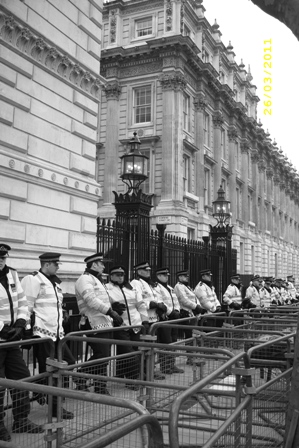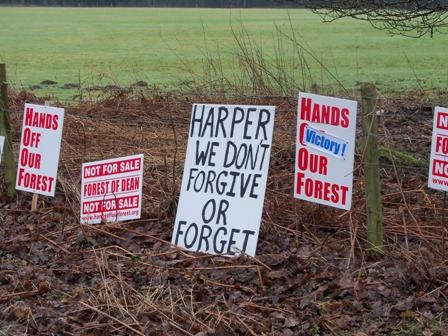The numbers taking part in the giant rally in London on March 26 varied according to which newspaper you read. The Independent on Sunday claimed half a million. Others settled for 400,000 – whilst the TUC, which had organised the protest, counted up to 250,000 before it ceased counting – whilst thousands were still arriving, to join the great procession that filled the streets of the capital.
But all agreed that it was the largest street demonstration since that held against the Iraq War n February 2003. No doubt Cameron and Clegg were taking note, but whether they will really get the message is another matter. But for those who took part in the protest (and many were marching for the first time), it was a reaffirmation of their determination not to take the swingeing cuts lying down, but instead to join the campaign for an alternative approach.
DAWN START:
There were coachloads from across the west, including the Forest of Dean, Monmouth and Gloucester. For us, it was an early start. We were up in the darkness before dawn broke, to drive up through a sleeping Forest to Cinderford to join sleepy-eyed demonstrators outside the Co-op store for our coach to London.
Gradually we woke up, as we headed along the motorway and then crawled through the traffic before being dropped off by the Tate gallery on the embankment. We joined the growing swell of fellow demonstrators, before being directed across the Lambeth Bridge to the south side of the river.
By now demonstrators seemed to be streaming in from all directions. We joined with others who were queuing for a boat to take us back to where the main march was assembling on the other side of the river.
BY BOAT:
Several boatloads ferried demonstrators back towards Blackfriars Bridge, where the tail end of the march was growing longer by the minute. Demonstrators with banners and placards who’d come to join the rally by coach, by train – and, in our case, by boat – were arriving all the time.
We made our way at a slow, shuffling pace along the Embankment, enlivened by music, and the chants of demonstrators as the march snaked its way slowly forward. Most of the major public sector unions were there, banners flying. Unison was out in force, as was Unite, and the health sector unions, including nurses and physiotherapists. Railway workers, too, and the Prison Officers Association (POA), proclaiming that “prisons were not for profit”. Quite right: the privatisation of the penal system should cause concern, to say the least.
The pace quickened slightly as we reached Big Ben and turned past Parliament where lines of police men clad in yellow high visibility jackets stood shoulder to shoulder behind barricades. The whole of Parliament Square was cordoned off for the occasion, and the march was routed to the right, up Whitehall and past the heavy iron gates that now bar Downing Street.
Around Trafalgar Square and on towards Piccadilly we saw the first signs of anarchists activists who later in the day were to indulge in their own unauthorised direct action. but by the time that took place we’d passed on by. They were working to a different agenda than the vast majority of the marchers, who were there in common cause to save our services, and to fight to protect our welfare state.
At last, after our long trudge through central London, we reached Hyde Park where the main rally and the speeches were taking place. We had already missed the main speakers – Ed Milliband, and Brendan Barber from the TUC – but we were able to take the weight off our feet, have a picnic, and meet up with old friends, whilst keeping half an ear open to the speeches relayed from the main platform.
FAMILY FRIENDLY:
The TUC had billed it as a “family friendly” occasion, and many on the march had brought their children. After all, the cuts will be affecting their future – even more so than they will affect ours. Indeed, the whole structure of care and support, of nurturing lives, built up since the war, is under threat from a government that believes a vague slogan, “the Big Society” will act as a cloak to their real intentions.
For many of the youngsters there was a play tent, provided by the Woodcraft Folk, where they could write their own messages to David Cameron – or draw pictures to send to the PM – on how they saw the cuts. Many were entering in to the spirit of the occasion (some no doubt guided by encouraging parents!).
The speeches included many from those whose work is already affected by the cutbacks – and one trade unionist who brought greetings from across the Atlantic and described how Republican administrations in states that they controlled were undermining welfare and trade union rights.
The last speech of the day came from Rich Daniels from the Dean, chairman of Hands Off Our Forest (HOOF). He spoke forcefully and articulately, including a few Forest anecdotes.
By then it was time to leave. We made our way along by the Serpentine and out of Hyde Park, heading up towards the Albert Hall where our coach was waiting to take us back to Cinderford. It had been a long day, but one that had been rewarding and worthwhile.
AN ALTERNATIVE:
It showed that more and more people are prepared to fight Cameron’s programme of cuts. That more and more of them are not prepared to accept his message that such a drastic pruning of welfare services is “necessary”.
Not only is there a growing realisation that the Government (backed by the Tory media) has been falsifying its claims in order to force through a hidden agenda, but also that there is an alternative strategy to reduce our national debts.
It wasn’t the parents, their children, the health care workers, the millions who work in the public sector, who caused the crisis in the first place. It was the bankers who were prepared to gamble recklessly with our money – and are still prepared to pay themselves big bonuses even after billions of pounds of taxpayers’ money has been poured into stabilising the banking system that caused the crisis in the first place.
So, if anyone should help to pay off the nation’s debts, surely it should be the guilty ones. The alternative strategy is for a “Robin Hood” tax, levied on the fat cats and their bonuses. Such a tax would hardly leave them impoverished. They would still be able to enjoy the rich life style they’re accustomed to – but they would have to take some financial responsibility for the state of the economy.
That, and the cancellation of such expensive and unwanted programmes as Trident renewal, should allow the Government to start putting money back into the economy and building up the public sector, rather than demolishing it brick by brick. But sadly we have a government in power that has an agenda far removed from that of the people who will suffer from its actions.
As Brendan Barber, general secretary of the TUC, declared in his speech to the rally, “WE are the Big Society“. It’s a concept that Cameron, Osborne and Co. no doubt would find hard to grasp.
{article by AG, photos by C. Spiby}









